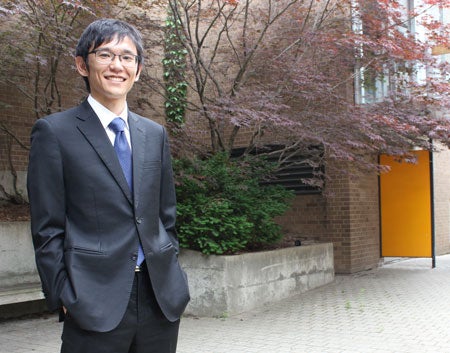
Heroics may actually hurt when lives are on the line
A digital model that simulates severe flooding from nearby rivers

A digital model that simulates severe flooding from nearby rivers
By Brian Caldwell Faculty of Engineering As a husband and a father, Eishiro Higo understands and admires the emotional impulse to put others first in life-and-death emergencies involving groups of people.
As a husband and a father, Eishiro Higo understands and admires the emotional impulse to put others first in life-and-death emergencies involving groups of people.
But as a researcher who has objectively examined the likely outcomes in such situations using computer modeling, he doesn’t recommend it.
A study led by Higo, a civil engineering PhD candidate at the University of Waterloo, found that overall survival rates were substantially higher when strong people in a 30-member group first reached safety themselves before trying to help weaker people in a simulated flooding crisis.
“We have to identify what is brave and what is reckless,” he says. “Helping people from a safe location is still good behaviour and the result is actually much better.”
The study involved a two-dimensional computer model of an actual three-level underground space in Kyoto, Japan that consists of a subway station, a parking garage and a shopping mall.
Inspired in large part by a devastating 2011 earthquake and tsunami in Higo’s native Japan, the model simulated severe flooding from a nearby river.
To survive, a mix of adults and senior citizens on the lower subway platform level had to reach safety on the surface via staircases.
Higo and his colleagues repeatedly ran the model using three different evacuation strategies: one in which people only worried about themselves; one in which people immediately worked together as a group; and one in which those capable of reaching a safe place did so first before trying to trying to save others using a rope.

In most life-and-death scenarios when variables such as the ratio of adults to seniors were adjusted, the rope strategy resulted in the highest overall survival rate.
In one typical scenario that assumed evacuation efforts beginning at a particular point in time, for instance, 12 of 30 people survived using the rope strategy, versus just five survivors using either of the other two strategies.
In effect, the results showed that when strong members try to help weak members before first securing themselves, they are dragged down and the group as a whole suffers.
“Foolhardiness is not a good strategy for rescuing,” says Higo, who did related research for his master’s degree at Kyoto University before coming to Waterloo in 2013.
Crucial to the success of the rope strategy in the simulation was the availability of simple tools for use by rescuers.
Design features including handrails and raised areas on stairs for evacuees to brace themselves or rest also markedly increased the chances of survival.
Higo hopes his findings spark discussion and the inclusion of such relatively inexpensive disaster preparedness design features in public spaces.
“In very critical situations, we have to be kind of selfish, but we can still help others if we have proper equipment and proper strategies,” he says.

Waterloo researcher Dr. Tizazu Mekonnen stands next to a rheometer, which is used to test the flow properties of hydrogels. (University of Waterloo)
Read more
Plant-based material developed by Waterloo researchers absorbs like commercial plastics used in products like disposable diapers - but breaks down in months, not centuries

Read more
Here are the people and events behind some of this year’s most compelling Waterloo stories

Engineering master's student Nayeema Nonta (left), one of the three paper authors, and her supervisor, Dr. Sirisha Rambhatla, in a large server room with the computer power needed to develop their new LLM training technique. (University of Waterloo)
Read more
Waterloo researchers develop highly efficient AI training system that paves the way for cheaper, greener “intelligent partners”
Read
Engineering stories
Visit
Waterloo Engineering home
Contact
Waterloo Engineering
The University of Waterloo acknowledges that much of our work takes place on the traditional territory of the Neutral, Anishinaabeg, and Haudenosaunee peoples. Our main campus is situated on the Haldimand Tract, the land granted to the Six Nations that includes six miles on each side of the Grand River. Our active work toward reconciliation takes place across our campuses through research, learning, teaching, and community building, and is co-ordinated within the Office of Indigenous Relations.